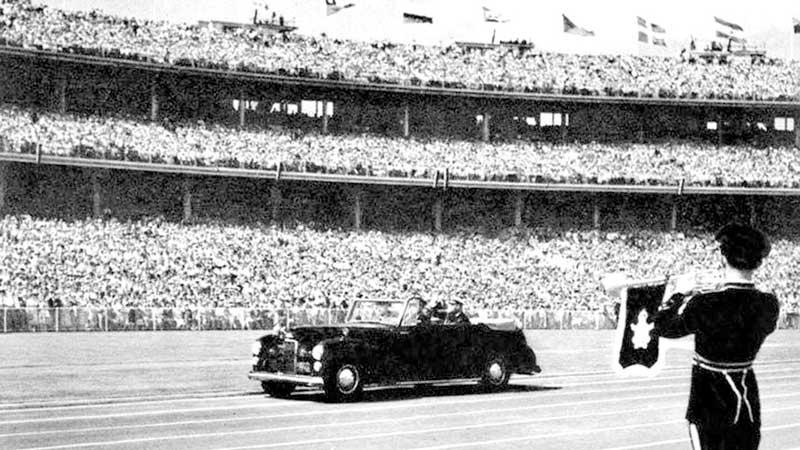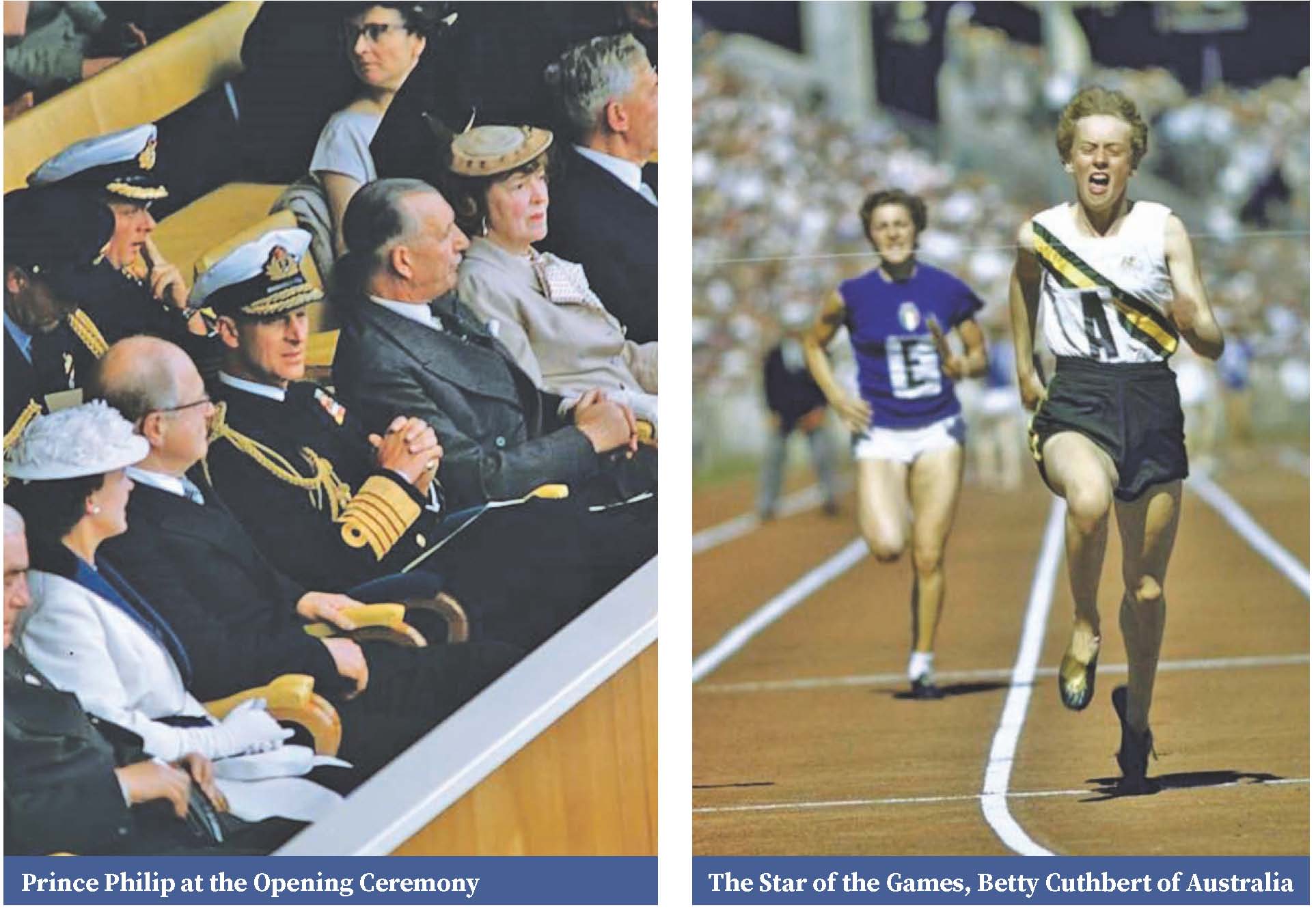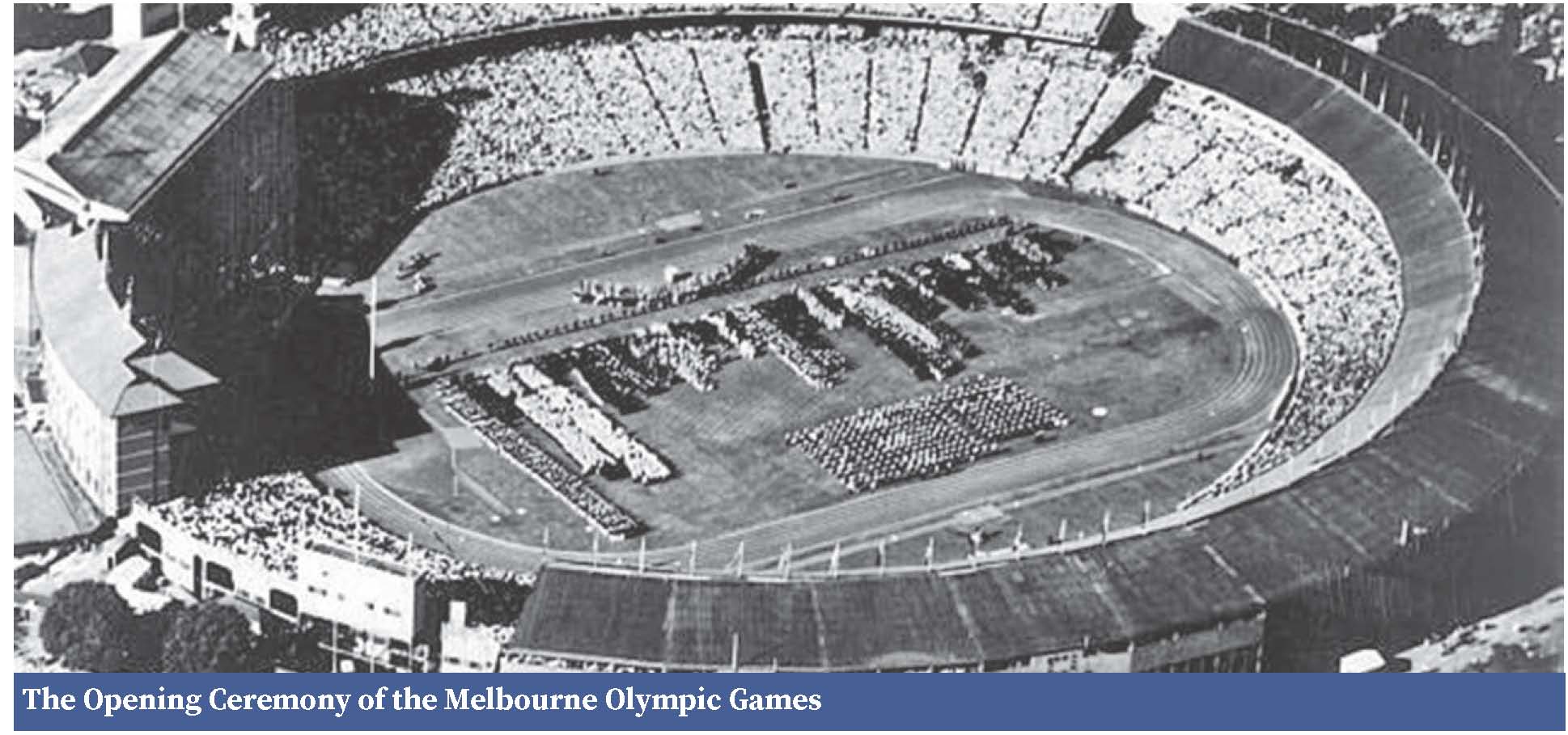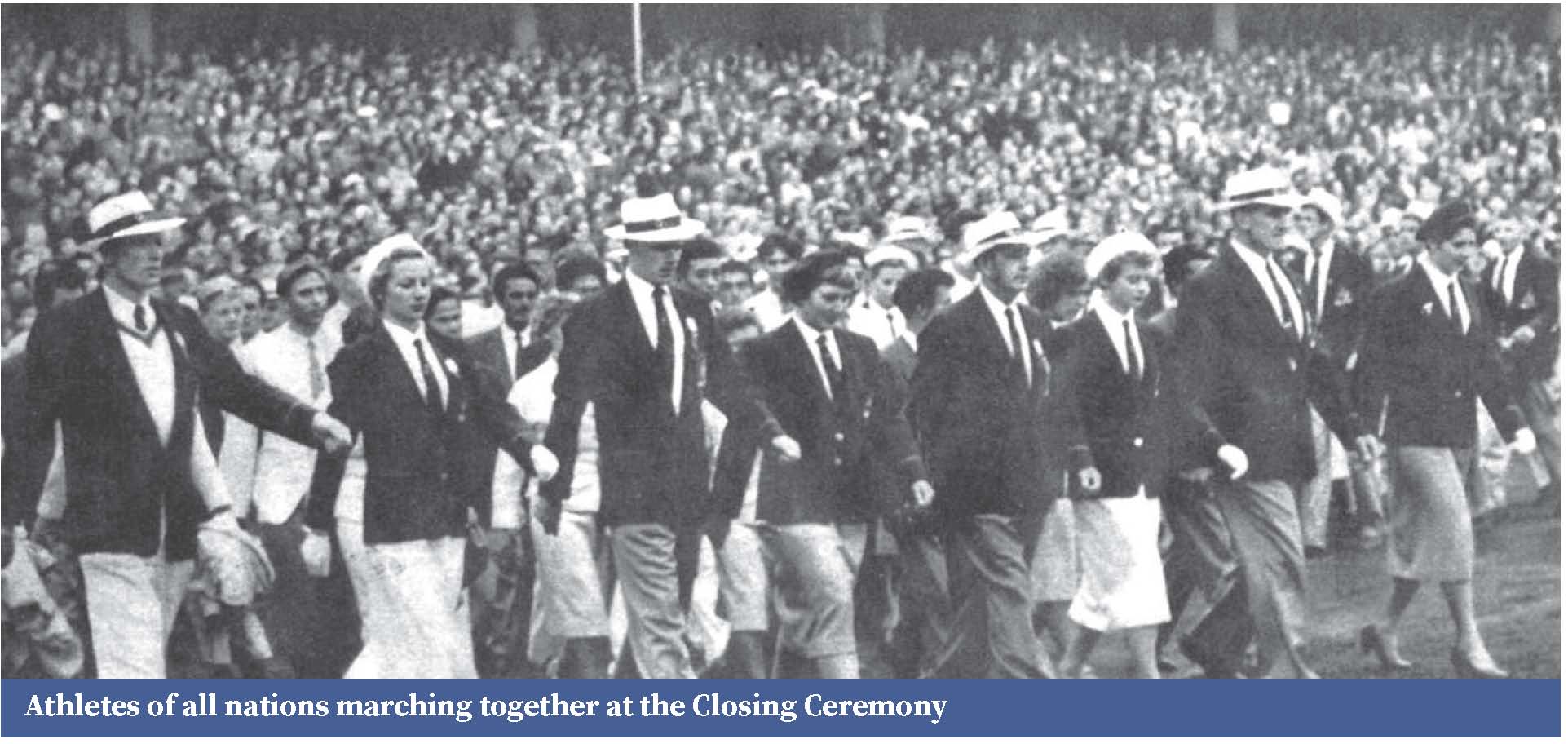
The 1956 Summer Olympic Games, officially known as the Games of the XVI Olympiad were held in Melbourne, Australia, from November 22 to December 8, 1956. More than 105,000 people packed the Melbourne Cricket Grounds (MCG) to witness a spectacle unlike any other in Australia at that time - the opening of the first Olympic Games held in the Southern Hemisphere.
His Royal Highness the Duke of Edinburgh, Prince Philip, arrived at the MCG in a Rolls Royce, resplendent in Naval uniform of an Admiral of the Fleet to open the Montreal 1956 Summer Olympic Games. These Olympics were the first to be staged outside Europe and North America. Melbourne, the capital of Victoria and the second largest city in Australia became the most southerly city ever to host the Olympic Games.
Due to the Southern Hemisphere’s seasons being different from those in the Northern Hemisphere, the 1956 Games did not take place at the usual time of year, because of the need to hold the events during the warmer weather of the host’s spring/summer. The Olympic equestrian events could not be held in Melbourne due to Australia’s strict quarantine regulations, so they were held in Stockholm, Sweden, in June 1956.
Despite uncertainties and various complications encountered during the preparations, the 1956 Games went ahead in Melbourne as planned and turned out to be a success. The 1956 Summer Olympics featured 17 different sports encompassing 23 disciplines, and medals were awarded in 151 events (145 in Melbourne and 6 in Stockholm). Australian football and baseball were demonstration sports in 1956.
The Soviet Union won 37 gold medals and emerged victorious. Their total tally was 98 medals – 37 gold, 29 silver and 32 bronze medals. The United States came second with 74 medals – 32 gold, 25 silver and 17 bronze medals. The host nation, Australia came third securing a total of 35 medals – 13 gold, 8 silver and 14 bronze medals.
Melbourne’s successful bid for 1956
Melbourne won the bid to host the 1956 Games on the fourth ballot of the IOC meeting in Rome on April 29, 1949, beating Buenos Aires, Argentina, by a single vote. Six United States cities and Mexico had also been in the running but, the Australian delegates had impressed. The Victorian Government’s flattering 13-minute colour film and the assurance given by the Australian Prime Minister on the financial support had truly favoured Melbourne.
Many members of the IOC were skeptical about Melbourne as a host city. Its location in the Southern Hemisphere was a major concern since the reversal of seasons would mean the Games must be held during the northern winter.
 The November–December schedule was thought likely to inconvenience athletes from the Northern Hemisphere, who were accustomed to resting during their winter. However, Melbourne was selected over bids from Buenos Aires, Mexico City, Montreal, Los Angeles, Detroit, Chicago, Minneapolis, Philadelphia and San Francisco.
The November–December schedule was thought likely to inconvenience athletes from the Northern Hemisphere, who were accustomed to resting during their winter. However, Melbourne was selected over bids from Buenos Aires, Mexico City, Montreal, Los Angeles, Detroit, Chicago, Minneapolis, Philadelphia and San Francisco.
The first sign of trouble was the revelation that Australian equine quarantine would prevent the country from hosting the equestrian competition. At one point, IOC President Avery Brundage even suggested Rome, which was to host the 1960 Games, as a replacement site. As late as April 1955, Brundage was still doubtful though construction was well under way in Melbourne. By the beginning of 1956, it was clear that Melbourne would be ready.
MCG’s selection as the main venue
Premier, John Cain Snr, met with the President, Melbourne Cricket Club, Dr. William McClelland, on January 22, 1953 and requested for the MCG, stating that his government had neither the desire nor the money to finance another ground. The MCG committee promptly held a special meeting and decided to support as the government considered the MCG in the public interest.
Construction work could not begin at the MCG until after the Australian visit of Her Majesty Queen Elizabeth II and Prince Philip in February 1954. The Queen opened the Victorian State Parliament on February 25, exercising her historic privilege by delivering a short speech, an event described as an unforgettable spectacle. The Queen later accepted the office of Patron in Chief of the Olympic Games. The Duke of Edinburgh was invited to open the Games.
Melbourne received strong support from the British officials at the IOC, including Lord Burghley, who acknowledged that the delay of finalizing the stadium had caused a little upset but he otherwise viewed Melbourne’s prospects in a positive light. Even after the location of the main stadium had been finalized, a number of other issues remained unsolved.
The Vice-President of the United States, Richard Nixon, visited Melbourne as part of a brief Australian tour in October 1953. He visited the MCG, predicted that the Melbourne Olympics would be a great success. He inspected Games plans during his visit to the Town Hall and said that the planning issues were similar in Los Angeles before the 1932 Games. The Vice-President assured his hosts that Melbourne had the essentials with the climate, the stadium and a wonderfully sports-minded people.
The September 1956 edition of the Organizing Committee’s official newsletter declared that the Olympic sites were ready, with the MCG being structurally complete and the technical installations underway. With three months to go, tickets sales had reached 700,000 and tickets were still available for most of the sports.
Participation and boycotts of nations
Although the number of countries participating (67) was almost the same as in 1952 (69), the number of athletes competing dropped sharply, from 4,925 to 3,342. This figure does not include the 158 athletes from 29 countries who took part in the Stockholm equestrian competition.
Eight countries made their Olympic debuts: Cambodia, Ethiopia, Fiji, Kenya, Liberia, Federation of Malaya, Sabah of Malaysia and Uganda. Five nations competed in the equestrian events in Stockholm, but did not attend the Games in Melbourne.
Egypt, Iraq, Cambodia and Lebanon announced that they would not participate in the Olympics in Melbourne in response to the Suez Crisis when Egypt was invaded by Israel, the United Kingdom and France. Athletes from both East and West Germany competed together as a combined team, a remarkable display of unity that was repeated in 1960 and 1964, but was then discontinued.
The Netherlands, Spain and Switzerland boycotted the event in protest at the Soviet Union presence in light of their recent crushing of the Hungarian Revolution. The People’s Republic of China chose to boycott the event because Taiwan had been allowed to compete. For the first time, the team of Republic of China effectively represented Taiwan.
Prince Philip’s trip to Australia
Prince Philip and the queen had actually attended the Helsinki 1952 Olympics, and two years later, went to Australia in 1954 when the country was gearing up for the Melbourne Summer Games. During the 1954 Commonwealth tour the queen and prince spent 58 days in Australia in February and March, a jammed schedule that took in visits to 57 towns and cities.
As Queen Elizabeth’s schedule would not permit her to attend the opening ceremony of the Melbourne 1956 Olympic Games, the Duke of Edinburgh, Prince Philip, took off on a trip to Australia and declared open the Olympics at the MCG on November 22, 1956. Actually, the Prince was on an extended tour of the British empire, including New Guinea and nearby islands, as well as a trip to Antarctic, the first member of royalty to travel that far south. He sailed on board Her Majesty’s Yacht Britannia.
It may have been Prince Philip’s most significant solo event in Australia, the importance of the Olympic Games to an ambitious young nation could hardly be overstated. However, the Prince as an 18-year midshipman aboard the battleship ‘Ramilles’ had made his first visit in 1940, just a year after he met Princess Elizabeth, who was then 13. Australia was at war, and the young Naval officer was back again in 1945, aboard the Royal Navy Destroyer ‘Whelp.’
The Games begin
After the declaration by the Duke of Edinburgh, there was a fanfare of trumpets and the Olympic flag was raised, followed by the release of 5,000 pigeons and a 21-gun salute. The Olympic Oath was taken by John Landy on behalf of the athletes. Rower Merv Wood, competing in his fourth Olympics, carried the Australian flag at the opening ceremony. Over the next 16 days, 3,184 athletes from 67 nations competed in 145 events across 17 sports in Melbourne. Australia fielded a large team of 314 athletes, including 44 women.
 The Olympic flame was relayed to Melbourne after being lit at Olympia on November 2, 1956. Greek runners took the flame from Olympia to Athens. The flame was transferred to a miner’s lamp, then flown by Qantas Super Constellation aircraft “Southern Horizon” to Darwin, Northern Territory.
The Olympic flame was relayed to Melbourne after being lit at Olympia on November 2, 1956. Greek runners took the flame from Olympia to Athens. The flame was transferred to a miner’s lamp, then flown by Qantas Super Constellation aircraft “Southern Horizon” to Darwin, Northern Territory.
A Royal Australian Air Force English Electric Canberra jet bomber transported the flame to Cairns, Queensland, where it arrived on November 9, 1956. The Mayor of Cairns, Alderman W. J. Fulton, lit the first torch. The torch design was identical to the torch used for the 1948 London Games. The first runner was Con Verevis, a local man of Greek parentage.
The flame was relayed down the east coast of Australia using die cast aluminum torches weighing about 1.8 kgs. The flame arrived in Melbourne on November 22, 1956, the day of the opening ceremony. The Olympic cauldron was lit at the Olympic stadium by Ron Clarke, who accidentally burned his arm in the process.
Most Outstanding Athlete of the Games
Elizabeth Alyse Cuthbert, affectionately known as “Betty” Cuthbert, an 18-year from Sydney, won 100m and 200m sprints and ran an exceptional final leg in 4x100m relay to overcome Great Britain’s lead and claim her third gold medal at Helsinki 1956. Also, she became the first Australian Olympian to win three gold medals at a Games. She was nicknamed Australia’s “Golden Girl.” She later won 400m at Tokyo 1964 Olympic Games. Cuthbert is the only athlete to win the 100m, 200m and 400m in the history of the Olympic Games.
She was named in 1998 an Australian National Treasure and was inducted as a Legend in the Sport Australia Hall of Fame in 1994 and the Athletics Australia Hall of Fame in 2000. During her career, she set world records for 60m, 100 yards, 200m, 220 yards and 440 yards. Cuthbert also contributed to Australian relay teams completing a win in 4x100m, 4x110 yards, 4x200m and 4x220 yards. Cuthbert had a distinctive running style, with a high knee lift and mouth wide open.
High achievers of the Games
Once underway, the Melbourne Games progressed smoothly. The veteran Australian Shirley Strickland repeated her 1952 win in the 80m hurdles and was also part of the winning 4x100m relay team, bringing her career Olympic medal haul to seven: 3 gold, a silver and 3 bronze medals.
Australia won all of the freestyle races, men’s and women’s, and collected a total of eight gold, four silver and two bronze medals in swimming. Murray Rose became the first male swimmer to win two freestyle events since Johnny Weissmuller in 1924, while Dawn Fraser won gold medals in 100m freestyle and in 4x100m relay as the leadoff swimmer of the team.
The United States won 15 of the 24 athletic events. U.S. sprinter Bobby Morrow led the way with gold medals in 100m, 200m and 4x100m relay. Soviet runner Vladimir Kuts won both 5,000m and 10,000m. Ronnie Delany won gold for Ireland in 1500m final, the last Olympic gold Ireland won in a track event. Ireland’s Ronnie Delany ran an outstanding 53.8 over the last lap to win 1,500m.
There was a major upset, marred briefly by controversy, in 3,000m steeplechase. Little-known Chris Brasher of Great Britain finished well ahead of the field, but the judges disqualified him for interfering with Norway’s Ernst Larsen, and they announced Sandor Rozsnyoi of Hungary as the winner. Brasher made an appeal which was supported by Larsen, Rozsnyoi, and fourth-place finisher Heinz Laufer of Germany. Subsequently, the decision was reversed and Brasher became the first Briton to win a gold in athletics since 1936.
Only two world records were set in track and field in Melbourne 1956. Mildred McDaniel, the first American woman to win gold in the sport, set a high jump record of 1.76m and Egil Danielsen of Norway overcame blustery conditions with a remarkable javelin throw of 85.71m.
Throughout the Hungarian athletes were cheered by fans from Australia and many gathered in the boxing arena when thirty-year Laszlo Papp of Hungary won his third gold in light-middleweight. The India national field hockey team won its sixth consecutive Olympic gold.
A few days later, the crowd was with the Hungarian water polo team in its match against the Soviet Union which took place against the background of the Soviet invasion of Hungary. The game became rough and, when a Hungarian was forced to leave the pool with a bleeding wound above his eye, a riot almost broke out. The police restored order and the game was called early, with Hungary leading 4 - 0, and the Hungarians went on to win the gold.
The United States basketball team, led by Bill Russell and K. C. Jones, put on perhaps the most dominant performance in the Olympic history. They scored more than twice as many points as their opponents and won each of their games by at least 30 points.
 Olga Fikotova who won Czechoslovakia’s solitary gold at the Montreal Olympics in discus throw became best known for her romance across ‘Cold War’ barriers with American hammer throw gold medalist Hal Connolly. Several months later, they married in Prague. Their witnesses were the legendary Czech Olympic gold medalists couple Emil and Dana Zatopek. The couple moved to the United States after marriage and Olga having represented the United States at 1960, 1964 and 1968 Olympic Games was the flag bearer for the United States at the 1972 Summer Olympics.
Olga Fikotova who won Czechoslovakia’s solitary gold at the Montreal Olympics in discus throw became best known for her romance across ‘Cold War’ barriers with American hammer throw gold medalist Hal Connolly. Several months later, they married in Prague. Their witnesses were the legendary Czech Olympic gold medalists couple Emil and Dana Zatopek. The couple moved to the United States after marriage and Olga having represented the United States at 1960, 1964 and 1968 Olympic Games was the flag bearer for the United States at the 1972 Summer Olympics.
Symbol of Unity at Closing Ceremony
The backdrop to the Games was political strife in the world. However, the Melbourne Olympics became known as the ‘Friendly Games’ after adopting a suggestion received on December 7, 1956 by the Chairman of the Organizing Committee, Sir Wilfred Hughes. It recommended that the athletes at the closing ceremony on December 8, should not march in their separate national groups, but should walk together as one group stressing that during the Games there will be only one nation.
War, politics and nationalities will be forgotten. What more could anybody want if the world could be made one nation. The change was approved in time and the more informal closing parade of athletes from all nations, mingling together, as a symbol of global unity took place. Ever since, it has become a popular Olympic tradition. Later in 1986, the originator was located in England and identified as then 17-year Chinese-Australian John Ian Wing.
The State Parliament hosted its reception in Queen’s Hall for Australia’s Olympic team on the evening of December 7, with Premier of Victoria, Sir Edward Bolte declaring Australia’s tally of 35 medals, which he described as a medal for every 260,000 of the population to be ‘a magnificent result.’
The Melbourne Olympic Games was over. The flag was lowered, as the scoreboard read, ‘Melbourne, the Olympic city, bids you farewell and bon voyage. Good luck Rome 1960.’ One report noted that even the Melbourne weather had played its part nobly. The Prime Minister of Australia, Sir Robert Menzies recalled the organization, the spectacle and the spirit of international goodwill that pervaded the Games as ‘a green and pleasant memory.’
(The author highlights spectrum of sports extravaganza. He is the winner of Presidential Academic Award for Sports in 2017 and 2018 and recipient of National Accolades for Academic pursuits. He possesses a PhD, MPhil and double MSc)
